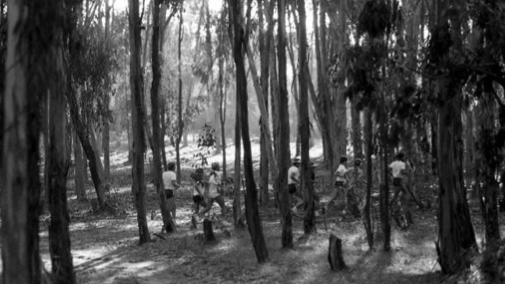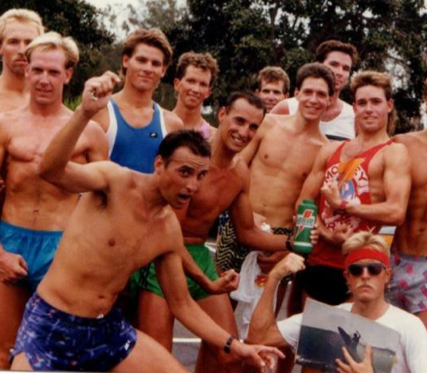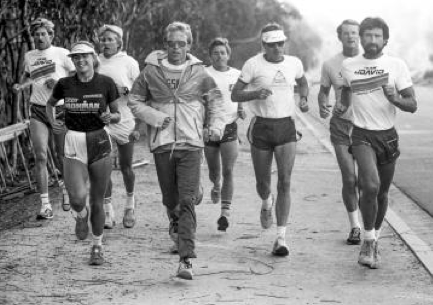In the 80’s and 90’s, if you were serious about triathlon, you moved to one of the small, sleepy beachfront towns north of San Diego. Like surfers looking for the best swells, you wanted to be on the home turf of the world’s best triathletes, seeking out the steepest competition, for training, and then more training. Weeks clicked by, deadened by monotony and repetition. Ten miles in the pool, 300 miles on the bike, 50 miles running. These were low weekly averages. So the Tuesday Group run was an aberration, a chance for a more informal training session, like jamming with friends playing music, but this one took place amid the maze-like horse trails of the very rich and private community of Rancho Sante Fe. These weekly runs grew in size over time, from a handful of plucky local triathletes to a gathering sweating tribe from new triathlon hotbeds like Germany and Australia. In the following essay, excerpted from a much longer piece on the website TriHistory http://www.trihistory.com/features/any-given-tuesday-morning, writer, author, and two-time Hawaii Ironman champion Scott Tinley takes up back in time to the Tuesday Group Run. It now longer exists. Its success brought about its own demise. –Bill Katovsky
Triathlon’s Legendary Tuesday Group Run: 20-Year San Diego Tradition
by Scott Tinley
Like many things that shaped the sport of triathlon, the Tuesday Run was catalyzed mostly by accident. And a little design. Nothing but a group of like-minded endurance freaks in search of their mirror deviates…in search of speed. When that handful of San Diego-based triathletes decided sometime in the spring of 1983 to meet every Tuesday morning, it began a 20-year streak of pleasure and pain. The time was 7:30 AM. and the entry point was a public street adjacent to the private Lomas Santa Fe Country Club. The venue was 50-some miles of groomed trails.
Imagine that: 30 to 50 athletes–some wealthy, some almost homeless–all coming together for 30 to 50 reasons. The Tuesday Run was never conceived as a pure training ground or a preparation for the pro ranks. It began with just a few friends out for a trail run. As long (11-14 miles) and as hard (average pace 6:00 minute mile) as it was, the legendary run began like most group workouts: one person calls another who calls another and shazaam, here we go.
And when those callers included future hall of famers, Scott Molina and Mark Allen; and early elites, Kenny Souza, Gary Peterson, George Hoover, Paul Huddle, and Wally and Wayne Buckingham…you just knew it was going to get snappy.
During the early 1980s, coastal North San Diego was not the best place to be a budding elite triathlon: it was the only place. Boulder was still a sleepy backwater of neo-hippies and counter-culture rock climbers. Australia was barely awake to the multisport movement and European endurance athletes couldn’t find a way to separate themselves from pro cycling’s bourgeoisie. But in places like Del Mar, Encinitas, and Solana Beach—the foundational locales of professional triathlon—there existed a dozen or so athletes who thought that maybe, just maybe, this new sport could offer a few bucks to pay the rent. A way of supporting the multisport dream. And on any given Tuesday morning, you’d find the best triathletes in the world tramping around those trails at speed.
 When the Tuesday Run unofficially began, it was never official. There might have been anywhere from 30 to 50 runners with abilities ranging from casual jogger to Olympic contender. And no one ever took charge. Not officially. No announcement in the paper, no entry form, no insurance, no coach, and until the Europeans showed up in the late 80s, very few pretensions. We’d all start out at a very slow jog, allowing the late arrivals to catch up after they’d stashed their keys or chugged that last sip of gas station coffee. We moved wistfully down through the marked paths of the adjacent San Dieguito Park and onto Sun Valley Road as some collective, happy to be fit, free, and unencumbered on a Tuesday morning.
When the Tuesday Run unofficially began, it was never official. There might have been anywhere from 30 to 50 runners with abilities ranging from casual jogger to Olympic contender. And no one ever took charge. Not officially. No announcement in the paper, no entry form, no insurance, no coach, and until the Europeans showed up in the late 80s, very few pretensions. We’d all start out at a very slow jog, allowing the late arrivals to catch up after they’d stashed their keys or chugged that last sip of gas station coffee. We moved wistfully down through the marked paths of the adjacent San Dieguito Park and onto Sun Valley Road as some collective, happy to be fit, free, and unencumbered on a Tuesday morning.
For the first mile, you could look around and see your best friends, smiling, joking, young, tan, and bitchin’. Tuesday was long enough after a past-weekend race to forget the vagaries of failure and too soon to be thinking about the next Saturday or Sunday’s looming event. Tuesday morning was a time for the present. By mile two, small groups would begin to form; whispers and grunts and suggestions: How do you feel, Bro? Where’s Bob and Mary? Who’s the new guy in neon? Do you have a loop in mind?
Organically sorted, by mile three, gloves came off.
“Don’t let the simple title fool you,” Huddle muses on the Tuesday Run. “Yes, this was a group running ‘workout’ but this was also an event. No one who went to a Tuesday Run slept well on a Monday night. They knew that the following morning would bring 11 to 14 miles of pain and suffering on a scale that often exceeded weekend races.”
 The quickened pace began innocently enough. Someone stopped laughing at the jokes. They’d adjust their headband, move to the front, clear their chest and spit. Nothing was said or needed to be. When the Tuesday Run started its thing, it felt as a supercar shifted from second to fourth gear. The lead pack dropped runners off the back like stages from a rocket. And by mile four the groups were set. But the route never was. And that made it interesting. Almost mythic.
The quickened pace began innocently enough. Someone stopped laughing at the jokes. They’d adjust their headband, move to the front, clear their chest and spit. Nothing was said or needed to be. When the Tuesday Run started its thing, it felt as a supercar shifted from second to fourth gear. The lead pack dropped runners off the back like stages from a rocket. And by mile four the groups were set. But the route never was. And that made it interesting. Almost mythic.
“You never knew exactly what to expect,” recalls six-time Kona champion, Mark Allen, “or from whom the dynamite trigger was going to be pushed.” The group never ran less than an hour and rarely more than two. But in that malleable window of time you could cover a lot of beautiful ground that, if you weren’t suffering interminably from the pace, was in fact, quite beautiful.
In some ways, the Tuesday Run was the first real aesthetic approach to triathlon: you showed up with a kind of wild-eyed wonder in your heart, let it all hang out amongst those blue gum trees, and went home thinking how wonderful that suffering had been. If you made it home.
“I was the victim of the ‘letting visitors lead’ trick,” remembers Heather Fuhr. “The first time at the Tuesday Run, Roch (Frey) and I were excited to be running with the big dogs, only to get dropped and completely lost. Two and a half to three hours later we finally made it back to the car. Lesson learned from that day on, know where you are going and don’t trust the big dogs.”
If you didn’t know the trails and were uh…abandoned, there were only two choices, both of which were bad. You could keep running in circles for hours or days until you stumbled on the parking lot or you could ask for directions from a local resident who would regard you as an interloper that might diminish their property values with your sweaty, shirtless presence.
Scott Tinley is also the author of “Racing the Sunset,” now available on Amazon’s Kindle and paperback in the summer.


